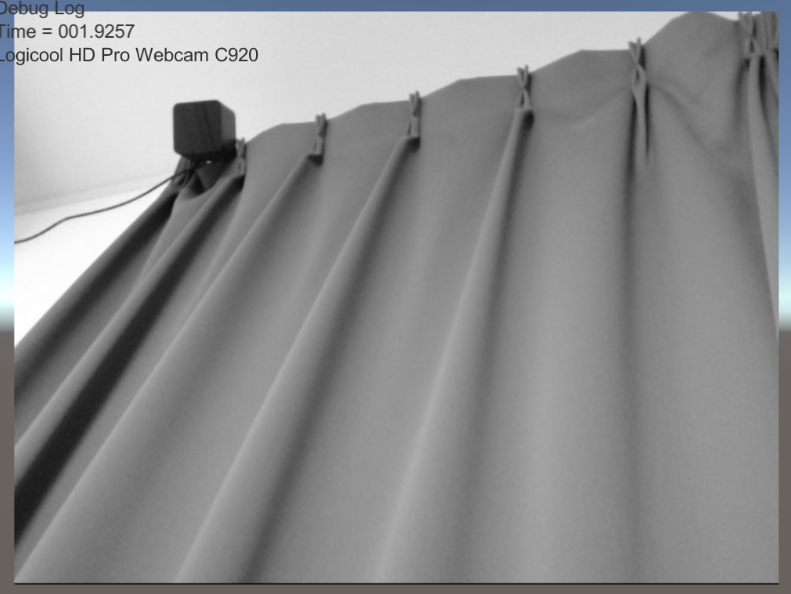ひとつ前の記事で Compute Shader を Android で実行するサンプルを載せましたので、今回はその Compute Shader を使ってカメラ画像をリアルタイムに処理します。

できました!
これからリアルタイムカメラ画像処理を Compute Shader で行う際は、以下のコードをコピペして使っていこうと思います。
using System.Collections; using System.Collections.Generic; using UnityEngine; public class DeviceCameraBehaviour : MonoBehaviour { // Histogram Gather public GameObject resultCube; public ComputeShader RGBA2GRAY; public Texture2D Source; RenderTexture _result; int _kernelIndex = 0; ComputeBuffer _HistogramBuffer = null; uint[] _emptyBuffer = new uint[256]; uint[] _histogramBuffer = new uint[256]; // Device Camera string _activeDeviceName = ""; WebCamTexture _activeTexture = null; // Use this for initialization void Start () { _HistogramBuffer = new ComputeBuffer(256, sizeof(uint)); for (int i = 0; i < _emptyBuffer.Length; i++) { _emptyBuffer[i] = 0; } _HistogramBuffer.SetData(_emptyBuffer); _kernelIndex = RGBA2GRAY.FindKernel("KHistogramGather"); RGBA2GRAY.SetBuffer(_kernelIndex, "_Histogram", _HistogramBuffer); } // Update is called once per frame void Update () { if (null != _activeTexture && _activeTexture.isPlaying && _activeTexture.didUpdateThisFrame) { if (null == _result) { _result = new RenderTexture(_activeTexture.width, _activeTexture.height, 0, RenderTextureFormat.ARGB32); _result.enableRandomWrite = true; _result.Create(); RGBA2GRAY.SetTexture(_kernelIndex, "_Source", _activeTexture); RGBA2GRAY.SetTexture(_kernelIndex, "_Result", _result); RGBA2GRAY.SetVector("_SourceSize", new Vector2(_activeTexture.width, _activeTexture.height)); _HistogramBuffer.SetData(_emptyBuffer); resultCube.GetComponent<Renderer>().material.mainTexture = _result; resultCube.transform.localScale = new Vector3((_activeTexture.width/(float)_activeTexture.height), 1, 1); } RGBA2GRAY.Dispatch(_kernelIndex, Mathf.CeilToInt(_activeTexture.width / 32f), Mathf.CeilToInt(_activeTexture.height / 32f), 1); } if (Input.GetKeyDown(KeyCode.Space)) { Debug.Log("Time = " + Time.time.ToString("000.0000")); PlayDeviceCamera(); } for (int i = 0; i < Input.touchCount; ++i) { if (Input.GetTouch(i).phase == TouchPhase.Began) { // Construct a ray from the current touch coordinates Ray ray = Camera.main.ScreenPointToRay(Input.GetTouch(i).position); // Create a particle if hit if (Physics.Raycast(ray)) { Debug.Log("Time = " + Time.time.ToString("000.0000")); PlayDeviceCamera(); } } } } private void PlayDeviceCamera() { WebCamDevice[] devices = WebCamTexture.devices; for (int i = 0; i < devices.Length; i++) { if (0 != string.Compare(_activeDeviceName, devices[i].name)) { if (null != _activeTexture) { _activeTexture.Stop(); } _activeDeviceName = devices[i].name; _activeTexture = new WebCamTexture(devices[i].name); _activeTexture.Play(); RGBA2GRAY.SetTexture(_kernelIndex, "_Source", _activeTexture); _result = null; Debug.Log(devices[i].name); break; } } } }
任意の解像度を指定するとか、細かいことをこの後入れていく感じですね。
同じコードで Android の方でも、リアルタイムカメラ画像処理できることを確認しました。